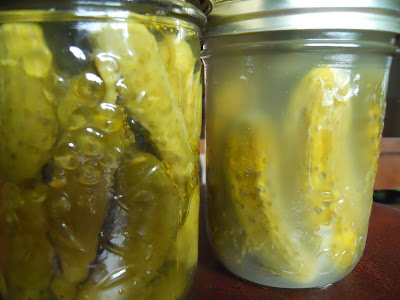As you can see, we made some pickles.
The cloudy brine doesn't make them look very good, does it?
So let me tell you about 'The Great Pickle Disaster':
It all started when I decided to buy a huge box of pickling cucs. I thought to myself, "Self, let's make some pickles so we can have them to give away for Christmas or whenever the mood strikes." Self replied, "That's a great idea, Jess''.
So away we went to my mama's house to make some pickles with her.
We packed the cucs in ice to make them extra crunchy.
We peeled cloves of garlic and bought coarse salt and big heads of fresh dill.
We made a vinegar brine.
We sterilized jars and lids, lids and jars.
We packed the pickles into these jars with dill, garlic, salt and brine and set them aside.
The next day they looked pretty good. A few jars hadn't sealed but that was no problem we'd just redo them.
So away we went.
We repacked the briny cucumbers in ice.
We remade the brine and we resterilized the lids and jars, jars and lids.
Then we restuffed all these jars with new garlic, salt, wilty dill, new brine and icy cold cucumbers.
Then we set these pickles aside.
Then you know what happened?
The original pickles that we thought had sealed started to get all cloudy and ominous and the lids began to pop up. No problem, I suppose....
So away we went (again).
We repacked, remade, resterilized, restuffed and set aside.
And do you know what happened???
(Remember this is the great pickle disaster not just the pickle disaster.)
Those pickles, they turned cloudy. All of them. Every single one.
So our great idea to make pickles? Not going so well.
Big box of pickling cucumbers = zero, zip, zilch pickles.
Then we did something smart.
We enlisted the wisdom of a senior lady from our church (Hi Mrs. Breck!) to aid us in the perils of pickle making.
So away we went.
We repacked shriveled cucumbers in ice.
We made new brine (with 7% acetic acid vinegar).
We resterilized jars and lids, lids and jars.
We restuffed the jars with shriveled cucumbers, salt, brine, garlic and dill and then we processed the jars for 5 minutes and set them aside.
And do you know what happened?!?
Every single jar sealed!
And then over the next few days and even weeks?
None of them turned cloudy.
And the great pickle disaster was transformed to pickle success.
That, my friends, is what happens when you don't process pickles.
Learn from our mistake... PROCESS YOUR PICKLES!
How to Make Pickles (the right way)
*I'm not exactly sure of the amounts here - we used 30lbs of pickles which made about 20 quarts and 6 pints. I think we used 2 heads of garlic for all those jars and about 6 cups of vinegar*
vinegar
coarse salt
dill
garlic cloves
pickling cucumbers
quarts and pint jars with rings and lids
Directions:
1. Pack cucumbers in ice (preferably overnight). Sterilize jars and lids. We put our jars in a 200°F oven and our lids in boiling water for at least 5 mins.
2. Make brine in a large pot on the stove using a 7:1 ratio of water to vinegar (ex: 7 cups water and 1 cup vinegar). Heat on medium high until it comes to a bowl.
3. Use a pot holder to grab a hot jar from the oven. Add to the jar: salt (for quarts add 1 tsp of salt and for pints add ½ tsp of sal), 1 clove of garlic and 1 head of dill. Stuff jar as full as possible with cucumbers leaving about 1 inch of head space. Add hot brine to the jar until cucumbers are covered. Wipe mouth of jar with a clean cloth and put on lid and ring. Set aside.
4. Continue doing this until you have enough pickle jars to fill a canner.
5. Fill canner half full of water. Place on stove and fill with jars. Turn heat on medium high and cover. When the canner begins to boil start a timer for 5 minutes. When the timer beeps, carefully remove jars and set to the side undisturbed for at least 12 hours.
6. Pickles are best left to 'pickle' for 6 weeks before enjoying.







No comments:
Post a Comment